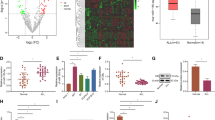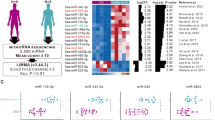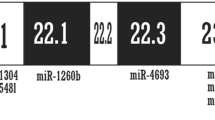Abstract
Among the microRNAs (miRNAs) that control different cellular processes, miR-24, miR-126 and miR-365 were shown to regulate cell cycle progression and apoptosis in various types of tumors. Interestingly, these three miRNAs were downregulated in pediatric TCF3-rearranged B-cell precursor acute lymphoblastic leukemia (BCP-ALL). Here, we showed that individual or combined overexpression of miR-24, miR-126 and miR-365 can neither alter the cell cycle progression nor the amount of apoptosis in 697, KASUMI-2 or MHH-CALL-3 TCF3-rearranged leukemic cells. We further integrated the miRNA–mRNA expression data of 37 children with BCP-ALL to identify candidate target genes for these three miRNAs. However, the expression levels of selected candidate target genes (ELL, EBF3 and IRF4 for miR-24, PITPNC1 for miR-126 and ZAP-70 for miR-365) did not reduce upon miRNAs overexpression in MHH-CALL-3 TCF3-rearranged leukemic cells. Although the expression level of AURKB—a validated target for miR-24—was reduced upon miR-24 overexpression in hepatocarcinoma HEP-G2 cells, overexpression of miR-24 cannot alter AURKB expression levels in MHH-CALL-3 TCF3-rearranged leukemic cells. Taken together, our data suggest that miRNAs’ function is highly tissue-dependent and that a defined biological target gene or function of one miRNA in a specific tissue cannot be extended as a generalized target/function for that miRNA in all types of cells/tissues.
This is a preview of subscription content, access via your institution
Access options
Subscribe to this journal
Receive 12 print issues and online access
$259.00 per year
only $21.58 per issue
Buy this article
- Purchase on Springer Link
- Instant access to full article PDF
Prices may be subject to local taxes which are calculated during checkout





Similar content being viewed by others
References
Friedman RC, Farh KK, Burge CB, Bartel DP . Most mammalian mRNAs are conserved targets of microRNAs. Genome Res 2009; 19: 92–105.
Lal A, Navarro F, Maher CA, Maliszewski LE, Yan N, O'Day E et al. MiR-24 inhibits cell proliferation by targeting E2F2, MYC, and other cell-cycle genes via binding to ‘seedless’ 3'UTR microRNA recognition elements. Mol Cell 2009; 35: 610–625.
Lerner M, Lundgren J, Akhoondi S, Jahn A, Ng HF, Akbari Moqadam F et al. MiRNA-27a controls FBW7/hCDC4-dependent cyclin E degradation and cell cycle progression. Cell Cycle 2011; 10: 2172–2183.
Akbari Moqadam F, Pieters R, den Boer ML . The hunting of targets: challenge in miRNA research. Leukemia 2013; 27: 16–23.
Jansson MD, Lund AH . MicroRNA and cancer. Mol Oncol 2012; 6: 590–610.
Volinia S, Calin GA, Liu CG, Ambs S, Cimmino A, Petrocca F et al. A microRNA expression signature of human solid tumors defines cancer gene targets. Proc Natl Acad Sci USA 2006; 103: 2257–2261.
Chang TC, Mendell JT . MicroRNAs in vertebrate physiology and human disease. Annu Rev Genom Hum Genet 2007; 8: 215–239.
Schotte D, De Menezes RX, Akbari Moqadam F, Khankahdani LM, Lange-Turenhout E, Chen C et al. MicroRNA characterize genetic diversity and drug resistance in pediatric acute lymphoblastic leukemia. Haematologica 2011; 96: 703–711.
Feng DD, Zhang H, Zhang P, Zheng YS, Zhang XJ, Han BW et al. Down-regulated miR-331-5p and miR-27a are associated with chemotherapy resistance and relapse in leukaemia. J Cell Mol Med 2011; 15: 2164–2175.
Zhang H, Luo XQ, Zhang P, Huang LB, Zheng YS, Wu J et al. MicroRNA patterns associated with clinical prognostic parameters and CNS relapse prediction in pediatric acute leukemia. PLoS One 2009; 4: e7826.
Kong KY, Owens KS, Rogers JH, Mullenix J, Velu CS, Grimes HL et al. MIR-23A microRNA cluster inhibits B-cell development. Exp Hematol 2010; 38: 629–640. e1.
Salvi A, Abeni E, Portolani N, Barlati S, De Petro G . Human hepatocellular carcinoma cell-specific miRNAs reveal the differential expression of miR-24 and miR-27a in cirrhotic/non-cirrhotic HCC. Int J Oncol 2013; 42: 391–402.
Guo Y, Fu W, Chen H, Shang C, Zhong M . MiR-24 functions as a tumor suppressor in Hep2 laryngeal carcinoma cells partly through down-regulation of the S100A8 protein. Oncol Rep 2012; 27: 1097–1103.
Mishra PJ, Song B, Mishra PJ, Wang Y, Humeniuk R, Banerjee D et al. MiR-24 tumor suppressor activity is regulated independent of p53 and through a target site polymorphism. PLoS One 2009; 4: e8445.
Xie Y, Tobin LA, Camps J, Wangsa D, Yang J, Rao M et al. MicroRNA-24 regulates XIAP to reduce the apoptosis threshold in cancer cells. Oncogene 2013; 32: 2442–2451.
Singh R, Saini N . Downregulation of BCL2 by miRNAs augments drug-induced apoptosis—a combined computational and experimental approach. J Cell Sci 2012; 125 (Part 6): 1568–1578.
Liu B, Peng XC, Zheng XL, Wang J, Qin YW . MiR-126 restoration down-regulate VEGF and inhibit the growth of lung cancer cell lines in vitro and in vivo. Lung Cancer 2009; 66: 169–175.
Miko E, Margitai Z, Czimmerer Z, Varkonyi I, Dezso B, Lanyi A et al. MiR-126 inhibits proliferation of small cell lung cancer cells by targeting SLC7A5. FEBS Lett 2011; 585: 1191–1196.
Feng R, Chen X, Yu Y, Su L, Yu B, Li J et al. miR-126 functions as a tumour suppressor in human gastric cancer. Cancer Lett 2010; 298: 50–63.
Li N, Tang A, Huang S, Li Z, Li X, Shen S et al. MiR-126 suppresses colon cancer cell proliferation and invasion via inhibiting RhoA/ROCK signaling pathway. Mol Cell Biochem 2013; 380: 107–119.
Lechman ER, Gentner B, van Galen P, Giustacchini A, Saini M, Boccalatte FE et al. Attenuation of miR-126 activity expands HSC in vivo without exhaustion. Cell Stem Cell 2012; 11: 799–811.
Nie J, Liu L, Zheng W, Chen L, Wu X, Xu Y et al. MicroRNA-365, down-regulated in colon cancer, inhibits cell cycle progression and promotes apoptosis of colon cancer cells by probably targeting cyclin D1 and Bcl-2. Carcinogenesis 2012; 33: 220–225.
Kang SM, Lee HJ, Cho JY . MicroRNA-365 regulates NKX2-1, a key mediator of lung cancer. Cancer Lett 2013; 335: 487–494.
Qin B, Xiao B, Liang D, Xia J, Li Y, Yang H . MicroRNAs expression in ox-LDL treated HUVECs: MiR-365 modulates apoptosis and Bcl-2 expression. Biochem Biophys Res Commun 2011; 410: 127–133.
Wu S, Huang S, Ding J, Zhao Y, Liang L, Liu T et al. Multiple microRNAs modulate p21Cip1/Waf1 expression by directly targeting its 3' untranslated region. Oncogene 2010; 29: 2302–2308.
Beckman JD, Chen C, Nguyen J, Thayanithy V, Subramanian S, Steer CJ et al. Regulation of heme oxygenase-1 protein expression by miR-377 in combination with miR-217. J Biol Chem 2011; 286: 3194–3202.
Akbari Moqadam F, Lange-Turenhout E, Ariës IM, Pieters R, den Boer ML . MiR-125b, miR-100 and miR-99a co-regulate vincristine resistance in childhood acute lymphoblastic leukemia. Leuk Res 2013; 37: 1315–1321.
van Iterson M, Bervoets S, de Meijer EJ, Buermans HP, t Hoen PA, Menezes RX et al. Integrated analysis of microRNA and mRNA expression: adding biological significance to microRNA target predictions. Nucleic Acids Res 2013; 41: e146.
Den Boer ML, van Slegtenhorst M, De Menezes RX, Cheok MH, Buijs-Gladdines JG, Peters ST et al. A subtype of childhood acute lymphoblastic leukaemia with poor treatment outcome: a genome-wide classification study. Lancet Oncol 2009; 10: 125–134.
Huber W, von Heydebreck A, Sultmann H, Poustka A, Vingron M . Variance stabilization applied to microarray data calibration and to the quantification of differential expression. Bioinformatics 2002; 18 (Suppl 1): S96–S104.
Johnson WE, Li C, Rabinovic A . Adjusting batch effects in microarray expression data using empirical Bayes methods. Biostatistics 2007; 8: 118–127.
Kertesz M, Iovino N, Unnerstall U, Gaul U, Segal E . The role of site accessibility in microRNA target recognition. Nat Genet 2007; 39: 1278–1284.
Griffiths-Jones S, Saini HK, van Dongen S, Enright AJ . miRBase: tools for microRNA genomics. Nucleic Acids Res 2008; 36: D154–D158.
Xiao F, Zuo Z, Cai G, Kang S, Gao X, Li T . miRecords: an integrated resource for microRNA-target interactions. Nucleic Acids Res 2009; 37: D105–D110.
Hsu SD, Lin FM, Wu WY, Liang C, Huang WC, Chan WL et al. miRTarBase: a database curates experimentally validated microRNA–target interactions. Nucleic Acids Res 2011; 39: D163–D169.
Goeman JJ, van de Geer SA, de Kort F, van Houwelingen HC . A global test for groups of genes: testing association with a clinical outcome. Bioinformatics 2004; 20: 93–99.
The R Development Core Team. R: A Language and Environment for Statistical Computing. R Foundation for Statistical Computing. ISBN’ 3-900051-07-0. R Development Core Team: Vienna, Austria, 2007.
Pathak S, Ma S, Trinh L, Eudy J, Wagner KU, Joshi SS et al. IRF4 is a suppressor of c-Myc induced B cell leukemia. PLoS One 2011; 6: e22628.
Crespo M, Bosch F, Villamor N, Bellosillo B, Colomer D, Rozman M et al. ZAP-70 expression as a surrogate for immunoglobulin-variable-region mutations in chronic lymphocytic leukemia. N Engl J Med 2003; 348: 1764–1775.
Rassenti LZ, Huynh L, Toy TL, Chen L, Keating MJ, Gribben JG et al. ZAP-70 compared with immunoglobulin heavy-chain gene mutation status as a predictor of disease progression in chronic lymphocytic leukemia. N Engl J Med 2004; 351: 893–901.
Holmlund T, Lindberg MJ, Grander D, Wallberg AE . GCN5 acetylates and regulates the stability of the oncoprotein E2A-PBX1 in acute lymphoblastic leukemia. Leukemia 2012; 27: 578–585.
Giglio S, Cirombella R, Amodeo R, Portaro L, Lavra L, Vecchione A . MicroRNA miR-24 promotes cell proliferation by targeting the CDKs inhibitors p27Kip1 and p16INK4a. J Cell Physiol 2013; 228: 2015–2023.
Nguyen T, Rich A, Dahl R . MiR-24 promotes the survival of hematopoietic cells. PLoS One 2013; 8: e55406.
Hartsink-Segers SA, Zwaan CM, Exalto C, Luijendijk MW, Calvert VS, Petricoin EF et al. Aurora kinases in childhood acute leukemia: the promise of aurora B as therapeutic target. Leukemia 2012; 27: 560–568.
Frampton AE, Krell J, Jacob J, Stebbing J, Castellano L, Jiao LR . Loss of miR-126 is crucial to pancreatic cancer progression. Expert Rev Anticancer Ther 2012; 12: 881–884.
Thomas M, Lieberman J, Lal A . Desperately seeking microRNA targets. Nat Struct Mol Biol 2010; 17: 1169–1174.
Croce CM . Causes and consequences of microRNA dysregulation in cancer. Nat Rev Genet 2009; 10: 704–714.
Chhabra R, Dubey R, Saini N . Cooperative and individualistic functions of the microRNAs in the miR-23a∼27a∼24-2 cluster and its implication in human diseases. Mol Cancer 2010; 9: 232.
Acknowledgements
This work was financially supported by the Netherlands Organization for Scientific Research (NWO-Vidi Grant, MLdB), the Quality of Life Foundation (MLdB/RP) and the Pediatric Oncology Foundation Rotterdam, KOCR (MLdB/RP).
Author contributions
FAM performed research, analyzed data and wrote the manuscript; JMB preformed the miRNA-mRNA expression data integration, analyzed the data and revised the manuscript; EAML-T performed research, analyzed data and revised the manuscript; RP and MLdB supervised research, analyzed data, wrote and revised the manuscript. All authors approved the final version of the manuscript.
Author information
Authors and Affiliations
Corresponding author
Ethics declarations
Competing interests
The authors declare no conflict of interest.
Additional information
Supplementary Information accompanies this paper on the Leukemia website
Supplementary information
Rights and permissions
About this article
Cite this article
Akbari Moqadam, F., Boer, J., Lange-Turenhout, E. et al. Altered expression of miR-24, miR-126 and miR-365 does not affect viability of childhood TCF3-rearranged leukemia cells. Leukemia 28, 1008–1014 (2014). https://doi.org/10.1038/leu.2013.308
Received:
Accepted:
Published:
Issue Date:
DOI: https://doi.org/10.1038/leu.2013.308
Keywords
This article is cited by
-
Copy number abnormality of acute lymphoblastic leukemia cell lines based on their genetic subtypes
International Journal of Hematology (2018)
-
Expression of Certain Leukemia/Lymphoma Related microRNAs and its Correlation with Prognosis in Childhood Acute Lymphoblastic Leukemia
Pathology & Oncology Research (2015)



